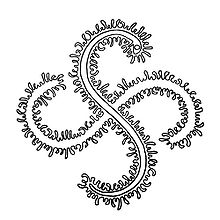Sugaar
 From Wikipedia the free encyclopedia
From Wikipedia the free encyclopedia
You can help expand this article with text translated from the corresponding article in Basque. (October 2022) Click [show] for important translation instructions.
|

In Basque mythology, Sugaar (also Sugar, Sugoi, Suarra, Maju) is the male half of a pre-Christian Basque deity associated with storms and thunder. He is normally imagined as a dragon or serpent. Unlike his female consort, Mari, there are very few remaining legends about Sugaar. The basic purpose of his existence is to periodically join with Mari in the mountains to generate the storms.
In one myth Sugaar seduces a Scottish princess in the village of Mundaka to father the mythical first Lord of Biscay, Jaun Zuria. This legend is believed to be a fabrication made to legitimize the Lordship of Biscay as a separate state from Navarre, because there is no historical account of such a lord. Only the fact that the delegates of Mundaka were attributed with the formal privilege of being the first to vote in the Biltzar (Parliament) of the province may look as unlikely indication of the partial veracity of this legend.
Etymology
[edit]The name Suga(a)r is derived from suge (serpent) and -ar (male), thus "male serpent".[1] The suggestions of a formation based on su (fire) and gar (flame), thus yielding "flame of fire" are considered folk etymology.[1]
Sugoi, another name of the same deity, has two possible interpretations, either a suge + o[h]i (former, "old serpent") or su + goi ("high fire").[citation needed] There is no likely etymology for the third name of this god, Maju.
Local legends on Sugaar
[edit]- In Ataun he is said to have two homes: in the caves of Amunda and Atarreta. He is said to have been witnessed crossing the sky in form of fire-sickle, what is considered presage of storms. In this area is also said that Sugaar punishes the children that disobey their parents.
- In Azkoitia Sugaar is clearly identified with Maju. He meets Mari on Fridays (the day of the akelarre or sabbat), conceiving then the storms.
- In Betelu Sugaar is known as Suarra and considered a demon. There they say that he travels through the sky in the shape of a fireball, between the mountains Balerdi and Elortalde.
See also
[edit]- Herensuge (Basque dragon)
References
[edit]- Dueso, José (1996). La primitiva religión de los vascos [The primitive religion of the Basques] (in Spanish). Orain S.A. ISBN 84-89077-56-8.